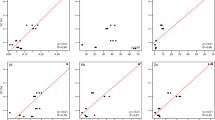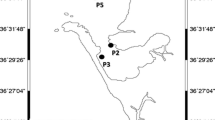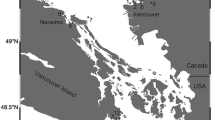Abstract
Background, Aims and Scope
Our study determined the role of light, aeration, grain size, amount of sediments and of water, density of animals and presence of additional food on the movement of Ilyanassa obsoleta. Spiked relative to reference sediments were also tested for avoidance or preference by the mud snails. Our goal was to develop exposure conditions to be used in future assessment studies of the environmental quality of sediments inhabited by mud snails. The behavioural response of the snails towards different concentrations of contaminated Halifax Harbour sediments placed in one half of a tank relative to reference sediments in the other half is examined in Part 2 and a chemical link investigated.
Methods
Animals were exposed in 7 L aquaria at 12°C to their native sediments placed in one or two halves of a tank and the effect due to the presence of a light source, air bubbles, sediment grain size, added algae examined relative to the snails’ behaviour. Preference or avoidance of one half of a tank relative to the second half, the immersed or dry glass surface represented the various media to be chosen by snails. After choosing the optimum set up, exposures were performed in triplicate, under slightly differing initial placement of the snails to compare means and variability in the results. Three specific biogenic chemicals, cholesterol, coprostanol and a fatty acid methyl ester (FAME) were spiked at 0.002, 0.01, 0.05, 0.25 and 1.2 mg/g, dry weight of sediment. A hexane, dichloromethane and methanol extract of harbour sediment were also spiked in reference sediments. In all cases, the location of the snails was recorded over a period extending up to 96 hrs.
Results
Twenty snails exposed during a 72 hrs period in commercial 7 L tanks containing 50 g of sediments (wet weight) in the bottom half of a tank filled half way with seawater represented the chosen conditions to test the avoidance/preference behaviour of snails for part of a tank. The presence of additional food on sediments attracted snails within 24 hrs of exposure.
Discussion
A general lack of preference was indicated in exposures to three biologically derived compounds spiked in reference sediments, i.e. a C-18 FAME, cholesterol and coprostanol. The repelling properties of a harbour sediment extract pointed to a role for non polar chemicals.
Conclusions
It is proposed that behaviour reflects a balance between the repelling effects of contaminants and the attractive value of food. The present study provides a robust green assessment tool that is easy to set up to assess the quality of sediments.
Recommendations and Perspectives
The interpretation of field observations regarding the abundance of animals during environmental assessments must consider both nutritional and toxicological causes. Additional laboratory exposures are needed to determine which chemicals play a role in the field.
Similar content being viewed by others
References
Castro H, Ramalheira V, Quintino V, Rodrigues AM (2006): Amphipod acute and chronic toxicity assessment in estuarine environmental monitoring: an example of Ria de Aveiro, NW Portugal. Mar Poll Bull 53, 91–99
Cammen LM (1980): Ingestion rate: an empirical model for aquatic feeders and detritivores. Oecologia 44, 303–310
Connor MS, Teal JM, Valiela I (1982): The effect of feeding by the mud snails, Ilyanassa obsoleta (Say), on the structure and metabolism of a laboratory benthic algal community. J Exp Mar Biol Ecol 65, 29–45
Cranford PJ (1988): Behaviour and ecological importance of a mud snail (Ilyanassa obsoleta) population in a temperate macrotidal estuary. Can J Zool 66, 459–466
Curtis LA, Hurd LE (1979): On the Broad Nutritional requirements of the mud snail, Ilyanassa (Nassarius) obsoleta (Say) and the polytrophic role in the food web. J Exp Mar Biol Ecol 41, 289–297
Giannotti AL, McGlathery KJ (2001): Consumption of Ulva lactuca (chlorophyta) by the omnivorous mud snail Ilyanassa obsoleta (Say). J Phycol 37, 209–215
Hellou J, Cheeseman K, Jovenelle M-L, Robertson S (2005): Behavioural response of Corophium volutator relative to experimental conditions, physical and chemical disturbances. Environ Toxicol Chem 24, 3061–3068
Hellou J, Langille M, Leonard J, Steller S, Tremblay D (2004): Partitioning of polycyclic aromatic hydrocarbons between water and particles and bioaccumulation in mussels: a harbour case. Mar Environ Res 59, 101–117
Hellou J, Yeats P, Steller S, Gagne F (2003a): Chemical contaminants and biological indicators of mussel health during gametogenesis. Environ Toxicol Chem 22, 2080–2087
Hellou J, Law RJ (2003b): Stress response of wild mussels, Mytilus edulis and Mytilus trossulus as an indicator of ecosystem health. Env Poll 126, 407–416
Hellou J, Steller S, Zitko V, Leonard J, King T, Milligan T, Yeats P (2002a): Distribution of PACs in surficial sediment and bioavailability to mussels, Mytilus edulis of Halifax harbour. Mar Environ Res 53, 357–379
Hellou J, Steller S, Leonard J, Albaiges J (2002b): Alkanes, terpanes and aromatic hydrocarbons in surficial sediments of Halifax harbour. Int J Polycyclic Aromatic Compounds 22, 631–641
Hyland JL, Miller DC (1979): Effects of No. 2 fuel oil on chemicallyevoked feeding behavior of the mud snail, Ilyanassa obsoleta. IN: Proceedings 1979 Oil Spill Conference, Los Angeles, CA. American Petroleum Institute, Washington, D.C. Publication No. 4308, 603–607
Lamoureux EM, Brownawell BJ (1999): Chemical and biological availability of sediment-sorbed hydrophobic organic contaminants. Environ Toxicol Chem 18, 1733–1741
Landrum PF, Eadie BJ, Faust WR (1992): Variation in the bioavailability of polycyclic aromatic hydrocarbons to the amphipod Diporeia (spp.) with sediment aging. Environ Toxicol Chem 11, 1197–1208
Lee WY, Welch MF, Nicol JAC (1977): Survival of two species of amphipods in aqueous extracts of petroleum oils. Mar Poll Bull 8, 91–94
Marklevitz SAC, Almeida E, Flemming J, Hellou J (2008): Determining the Bioavailability of Contaminants and Assessing the Quality of Sediments. Part 2: Behavioural Response of Snails, Ilyanassa obsoleta, Towards Contaminated Harbour Sediments. J Soils Sediments 8(2) 92–97
Morrison HA, Gobas FAPC, Lazar R, Haffner GC (1996): Development and verification of a bioaccumulation model for organic contaminants in benthic invertebrates. Environ Sci Technol 30, 3377–3384
Pace ML, Shimmel S, Darley WM (1979): The Effects of grazing by Gastropod, Nassarius obsoletus, on the benthic microbial community of a saltmarsh mudflat. Est Coast Mar Sci 9, 121–134
Scheltema RS (1964): Feeding Habits and Growth in the Mud-Snail Nassarius obsoletus. Chesapeake Sci 5, 161–166
Prouse NJ, Ellis DV (1997) A baseline survey of dogwhelk (Nucella lapillus) imposex in eastern Canada (1995) and interpretation in terms of tributyltin (TBT) contamination. Environ Techn 18, 1255–1264
Takada H, Eganhouse RP (1998): Molecular markers of anthropogenic waste. In: Meyers RA (eds), Environmental analysis and remediation. John Wiley & Sons Inc., pp 2883–2940
Wendt PH, Van Dolah RF, Bobo MY, Mathews TD, Levisen MV (1996): Wood preservatives leachates from dock in an estuarine environment. Arch Environ Contam Toxicol 31, 24–37
Author information
Authors and Affiliations
Corresponding author
Rights and permissions
About this article
Cite this article
Marklevitz, S.A., Almeida, E., Flemming, J. et al. Determining the bioavailability of contaminants and assessing the quality of sediments. J Soils Sediments 8, 86–91 (2008). https://doi.org/10.1065/jss2008.02.275.1
Received:
Accepted:
Published:
Issue Date:
DOI: https://doi.org/10.1065/jss2008.02.275.1




